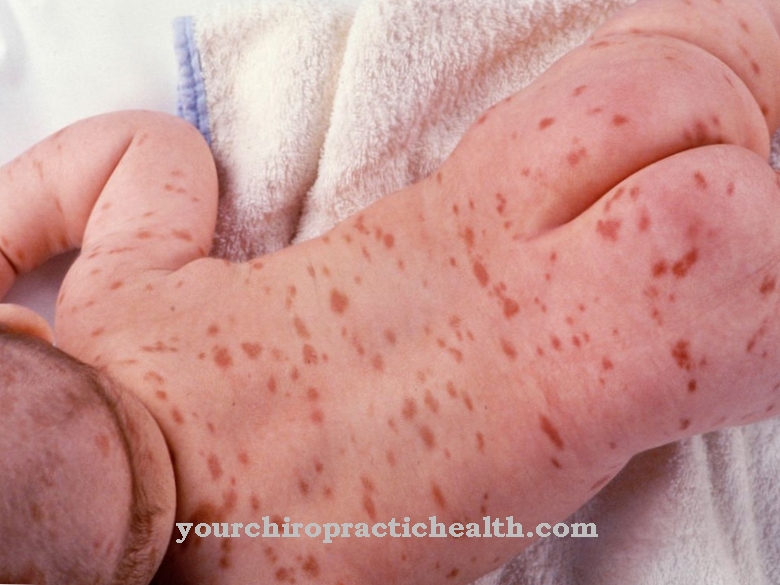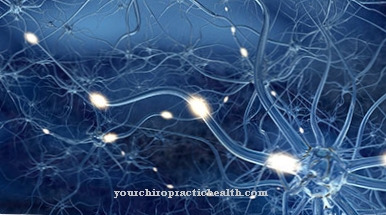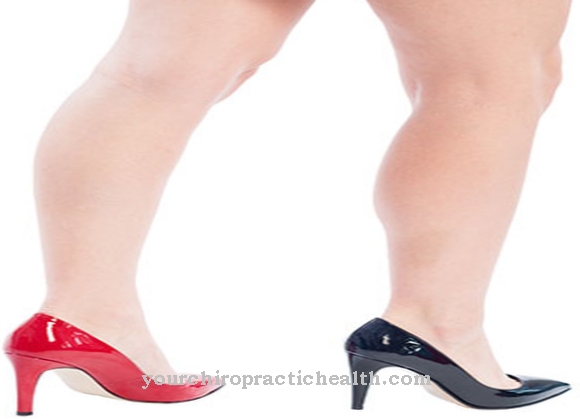The Wrinkly Skin Syndrome is probably a form of the cogenital cutis laxa type Debré and is associated with wrinkled skin, skeletal anomalies and facial malformations. A hereditary mutation was identified as the cause, which is also considered to be the cause of cutis laxa. So far, only symptomatic treatments have been the option for therapy.
What is Wrinkly Skin Syndrome?
Different diseases of the connective tissue are summarized as cutis laxa syndromes, which are associated with different accompanying symptoms and which have different mutations as the cause. The so-called Wrinkly Skin Syndrome has significant similarities with the cutis laxa of the Debré type, which is associated with more severe changes in the tissue, growth retardation and skeletal anomalies.
For this reason, the wrinkly skin syndrome is currently believed to be a special form of cutis laxa. Some scientists even believe that Cutis laxa Debré and Wrinkly Skin Syndrome are two manifestations of the same condition. So far, only 30 cases have been described by the WSS. The symptom complex is assigned to the hereditary diseases. The connection with Cutis laxa is currently one of the main research areas.
causes
Wrinkly skin syndrome does not seem to occur sporadically. In the 30 cases described so far, a familial cluster was observed, which is apparently based on an autosomal recessive inheritance. This inheritance is also the form of inheritance for the cutis laxa syndrome type Debré. As for the cutis laxa syndrome, mutations are also considered to be the actual trigger for the wrinkly skin syndrome.
The causative genes have not yet been identified in all patients. Mutations in the ATP6V0A2 gene at gene locus 12q24.31 have been found in some patients with WSS. Cutis laxa Debré can also be traced back to mutations in the same gene. Other patients showed mutations in the PYCR1 gene at locus 17q25.3, which are typical causes for ARCL2, GO or DBS.
Exactly what connections the mutation is due to have not yet been conclusively clarified due to the small number of cases documented to date. A mutation can result from exposure to toxins during pregnancy, for example, but also from an unbalanced diet or similar connections.
Symptoms, ailments & signs
The clinical symptoms of wrinkly skin syndrome usually manifest themselves in newborns. The symptoms reach their full extent by early childhood at the latest. Like cutis laxa, the wrinkly skin syndrome is primarily characterized by wrinkled skin on the back of the hand and foot, which causes a pre-aged appearance. Those affected have a higher number of palmar and plantar furrows than the average.
The skin of the abdomen can also be wrinkled. In addition to the dermal manifestations, there are bony manifestations in the form of multiple skeletal abnormalities. For example, the patient's joints can be hyperextended. Congenital hip dislocation is common. The anterior fontanel on the skull closes late, which is often associated with microcephaly. Growth is delayed even in the prenatal phase.
The growth retardation continues postnatally and is associated with a retarded development. Often there are accompanying symptoms of dysmorphism in the face. These dysmorphisms include a wide bridge of the nose, a downward-pointing eyelid and hypertelorism. The clinical picture of the symptom complex is somewhat milder than in patients with cutis laxa, but nevertheless shows significant overlaps. Clinically, the Wrinkly Skin Syndrome can also be similar to the symptoms of geroderma osteodysplastica or patients with De Barsy syndrome.
Diagnosis & course of disease
The diagnosis of wrinkly skin syndrome can be made through molecular genetic tests. A suspected diagnosis already overtakes the doctor through a visual diagnosis. If there is a mutation in the ATP6V0A2 gene at gene locus 12q24.31, the diagnosis is considered proven.
Since a WSS is not associated with pathognomonic histological findings such as severe anomalies of the elastic fibers, it is relatively easy to differentiate between ARCL2 and ARCL1. If the PYCR1 gene is mutated at locus 17q25.3, it is more difficult to distinguish it from other diseases. The causal mutation determines the prognosis. The prognosis is most favorable for mutations in the ATP6V0A2 gene.
Complications
Wrinkly skin syndrome affects those affected by a number of different skin conditions. For this reason, there is often a reduced self-confidence and sometimes inferiority complexes. This can lead to mental disorders or depression if patients are dissatisfied with their appearance or are ashamed of their bodies.
The quality of life of the person affected is considerably reduced and restricted due to the wrinkly skin syndrome. Furthermore, scars can develop on the skin, which can only be treated to a limited extent. These scars usually remain on the affected person's entire life. Especially in children, wrinkly skin syndrome can lead to severe depression or to bullying and teasing.
The skin itself can be damaged very easily, so that those affected may suffer from a reduced life expectancy. The syndrome also significantly increases the likelihood of developing cancer. Since a causal treatment of the syndrome is usually not possible, only the individual symptoms can be treated. There are no complications. However, complete healing is not possible.
When should you go to the doctor?
The birth of a person usually takes place in the company and support of a medical professional. In a routine process, the obstetricians take over the initial examinations of the child immediately after the birth. Anomalies and irregularities are documented. Medical treatments are then initiated if there are any special features. Parents and relatives therefore often do not have to take any action during this phase, as it is a predetermined process. If no special feature of the health condition of the newborn is noticed immediately after the birth, the first abnormalities will appear within the next few weeks or months at the latest.
A doctor should be consulted if optical discrepancies can be noticed. If the infant's appearance is unusual or skin abnormalities can be seen, a doctor should be consulted. A pre-aged appearance is characteristic of the disease. For this reason, parents should initiate a doctor's visit as soon as they notice visual abnormalities in their offspring. Action is required as soon as the infant shows abnormalities in direct comparison to peers.
When growth is delayed, there is also a need to see a doctor. Disorders of movement sequences and locomotion must be examined and treated. Since this genetic disease is a lifelong impairment, adequate health care should be initiated as soon as possible.
Therapy & Treatment
There is no causal therapy for patients with wrinkly skin syndrome. Gene therapy approaches are currently the subject of medical research, but they are not yet suitable for use on living people. Therefore, patients of the symptom complex currently have to be satisfied with a symptomatic treatment of their complaints, which after a breakthrough in gene therapy can perhaps be replaced by causal therapy in the future.
The symptomatic treatment of the syndrome is similar to the treatment of cutis laxa. Cosmetic surgery is not indicated for the syndrome. However, firming measures such as gymnastics, hot and cold showers or connective tissue massages can improve the complexion. The dysmorphisms in the face do not necessarily have to be corrected surgically. In theory, however, surgical interventions in this area are conceivable.
Physiotherapeutic care and early support are recommended to counteract developmental delays. The physiotherapeutic measures can help to avoid overstretching the joints through targeted muscle building. In this way muscles can stabilize the joints under certain circumstances. Skeletal abnormalities may need to be corrected surgically.
This applies, for example, to hip dislocation, which should be compensated for in an operation. In this way, secondary diseases can be avoided. Skeletal anomalies could, for example, promote osteoarthritis without intervention by a surgeon, which is usually caused by incorrect loading and malpositions.
You can find your medication here
➔ Medicines against redness and eczemaprevention
The wrinkly skin syndrome cannot be prevented so far, since apart from the triggering gene mutation, many causal relationships have not yet been conclusively clarified. Above all, the small number of documented cases does not give research sufficient support to identify causal factors or even preventive measures.
Aftercare
Since wrinkly skin syndrome is a congenital and therefore genetically determined disease, it usually cannot heal itself, so that the person concerned is always dependent on the examination and treatment by a doctor. The measures and the options for follow-up care are usually significantly limited.
First and foremost, a rapid diagnosis should be made in order to prevent further symptoms and complications from occurring. If the person concerned or the parents want to have children, genetic testing and counseling may be advisable in order to prevent the disease from recurring. Wrinkly skin syndrome is usually treated by means of physiotherapy or physiotherapy.
Those affected can repeat many of the exercises in their own home and thus speed up healing. Regular checks and examinations by a doctor are also very useful in order to monitor the symptoms on a permanent basis. Wrinkly skin syndrome usually does not limit the life expectancy of those affected. Contact with other people affected by the disease can also be very useful, as it can lead to an exchange of information, which makes everyday life easier for the person affected.
You can do that yourself
Wrinkly skin syndrome can sometimes be treated by those affected themselves. The noticeable areas of skin on the arms and legs as well as on the face can be reduced by using suitable creams and good skin care. It is also important to drink enough fluids to reduce wrinkled skin. The diet should be rich in vitamins and fiber and optimally support the already weakened skin.
The various malformations are treated surgically and with physiotherapy. Physiotherapy can be supported by regular training at home. However, strenuous physical activities should be avoided, especially in the case of severe skeletal abnormalities such as the typical hip dislocation. In addition, the sick children need various drugs, the intake of which must be closely monitored. Later on, therapeutic support can also be useful.
In children and adolescents, the external abnormalities and the restricted movement represent an increasing emotional burden and the patients need a contact person. This can be the specialist or a self-help group. It is important to provide information at an early stage with the help of child-friendly brochures that treat wrinkly skin syndrome. The rare disease must be treated permanently and the accompanying measures planned for the long term.



.jpg)
.jpg)























.jpg)